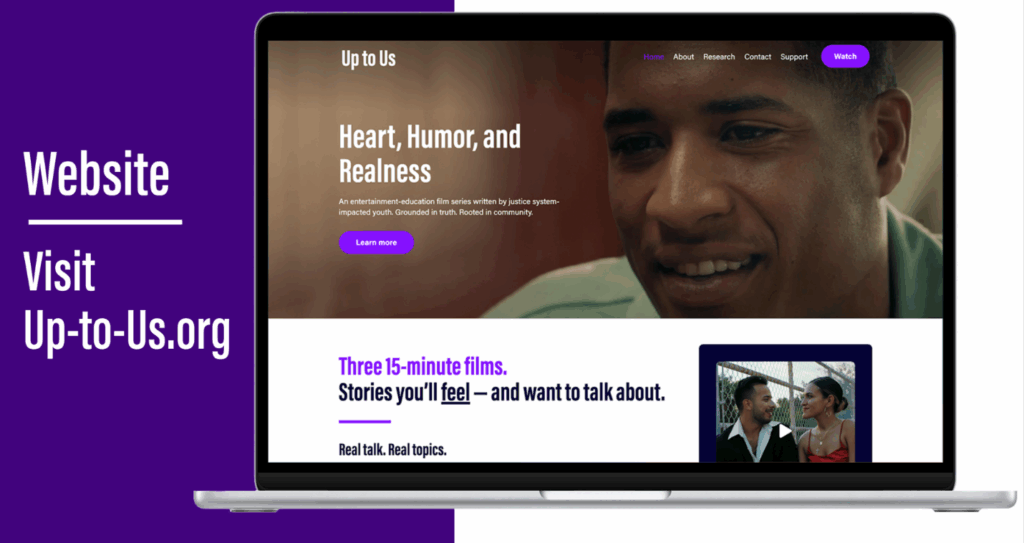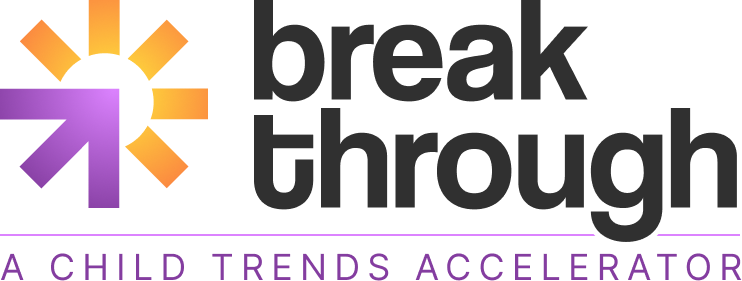By Amanda Harris, Wilna Julmiste Taylor, and Jai Williams
The Up to Us team is using short films to change how we talk with young people, ages 17–25, about sexual health, especially with those affected by the justice system. You can see a trailer for their films and request access to the full series on the Up to Us website.
The Up to Us team includes practicing artists who draw on entertainment and education to prompt engaging, honest conversations. Team members also bring personal experience with the justice system, which shapes their work in powerful ways. During Breakthrough’s first cohort, coaches Sarah Axelson and Kate Welti supported the team in revising their educational guide and implementation approach and developing a strong pitch to potential future partners and funders.
With a bold vision to replace shame with knowledge, isolation with connection, and silence with dialogue, Up to Us is showing that sexual health education can be creative, relevant, and rooted in real life. In this Q&A, Breakthrough spoke with Wilna Julmiste Taylor, Amanda Harris, and Jai Williams of Up to Us about their innovation journey.

The team developed Up to Us, a program that uses films and workshops full of humor, improvised activities, and collaborative discussions to create a space for vulnerability, community, and critical thinking. From left to right: Wilna Julmiste Taylor, Amanda Harris, Jai Williams.
Can you start by briefly describing your innovation and why it’s important for young people?
We know that young people are immersed in and deeply influenced by pop culture and entertainment. They get a lot of their information about sex, love, and relationships through social media, film, and television, which helps fill the gaps of what is often insufficient classroom-based sex-ed.
Our innovation, Up to Us, is a film series that includes three 15-minute episodes written and developed by young people with a range of experiences, particularly formerly incarcerated and system-impacted youth. It aims to provide sexual health education through entertainment-education, a practice that disseminates health information through relatable characters and emotionally engaging storylines to encourage behavioral and attitudinal changes. The Up to Us episodes cover sexual health topics that young people are most concerned about, including birth control, testing for sexually transmitted infections, consent, and more. We also have a website with bonus content and a guide for educators and caregivers to use alongside the films.

The films spark the dialogue, and the educational guide keeps it going. Learn more by visiting https://up-to-us.org/.
What makes this work different?
What makes Up to Us unique is its arts-based approach. We center vulnerability and storytelling as tools for learning and connection. Our goal is to create content that feels real and authentic—stories that allow people to feel seen. We avoid one-dimensional characters and narratives; instead, we strive to model a variety of possibilities and present the full spectrum of human experience.
By doing so, we hope to inspire young people to be fully themselves and to move beyond the stereotypes that often limit how they’re represented in research and media.
As you tested your innovation, what did you learn?
We piloted our intervention across Southern California at various reentry spaces and community organizations focused on supporting system-impacted young people, most between the ages of 17 and 25. This involved showing the Up to Us films and facilitating the corresponding interactive, workshops.
We received positive feedback on the relatability and quality of the film content and workshop activities, as well as suggestions for future iterations. In recent screenings, audiences spoke to the authenticity of the characters, particularly the male characters of Jacob and James who model honesty, non-violent communication, and emotional vulnerability.
When asked about their perceptions of Up to Us, 9 out of 10 viewers rated the overall quality of the videos as “very good” or “excellent” and the same proportion said that they would recommend the videos to a friend. Participants also acknowledged the power of our workshops.
How do you envision this innovation impacting the young people you aim to reach?
When sexual health narratives are done well, they can be incredibly engaging and beneficial for audiences. For example, Sex Education on Netflix was streamed by over 40 million viewers within its first month of release. East Los High was an Emmy-nominated series that aired from 2013 to 2014; extensive research demonstrated that it helped improve attitudes and behaviors among young people in Los Angeles.
There is a continual need for content that balances entertainment and education. We pick up where those shows left off. We see the success of these programs but also think that there is a need for more. Up to Us offers a wider range of characters, including system-impacted and formerly incarcerated individuals, for example. These stories have the power to impact young people nationally and globally.
What’s one experience or reaction to Up to Us that has stayed with you?
Many of our pilot viewers were formerly incarcerated young men of color. After viewing one episode in which a young man of color gets sexual health care at a community clinic, a male viewer shared that he hadn’t realized men could even receive services at a health clinic. That comment sparked a passionate discussion among the group about how men and women should be empowered to go to sexual health clinics and how having a friend join you at the clinic can improve the experience.
What role did Breakthrough play in your journey?
The Breakthrough Accelerator has been an invaluable support system for our team. They provided both strategic guidance and practical accountability. Our coaches introduced us to an entertainment industry consultant who was able to provide expert insights that grounded our ideas in real-world applicability.
Throughout the process, our coaches pushed us to refine our thinking, challenge our assumptions, and step outside of our comfort zones. Their encouragement helped us remain committed to the project even when balancing the demands of full-time jobs and doctoral student responsibilities. One of the most meaningful aspects of this experience has been how Breakthrough helped us adopt an entrepreneurial mindset—treating our work not only as a creative and research-driven endeavor but also as something with the potential for profit and for real-world impact.
What’s next for Up to Us?
We’re ready to grow! We are actively seeking collaborators who can help us bring more episodes of Up to Us to life and to more viewers.
We’re looking to work with entertainment industry professionals to broaden our reach to young audiences across the United States and globally. We’re also looking for opportunities to show screenings of Up to Us and ongoing partnerships with community organizations whose mission aligns with ours.
Lastly, we’re eager to present at conferences, panels, and film festivals where people are looking for bold, youth-centered stories.
You can learn more about our entertainment-education approach on our website and check out clips of our episodes on Instagram.

